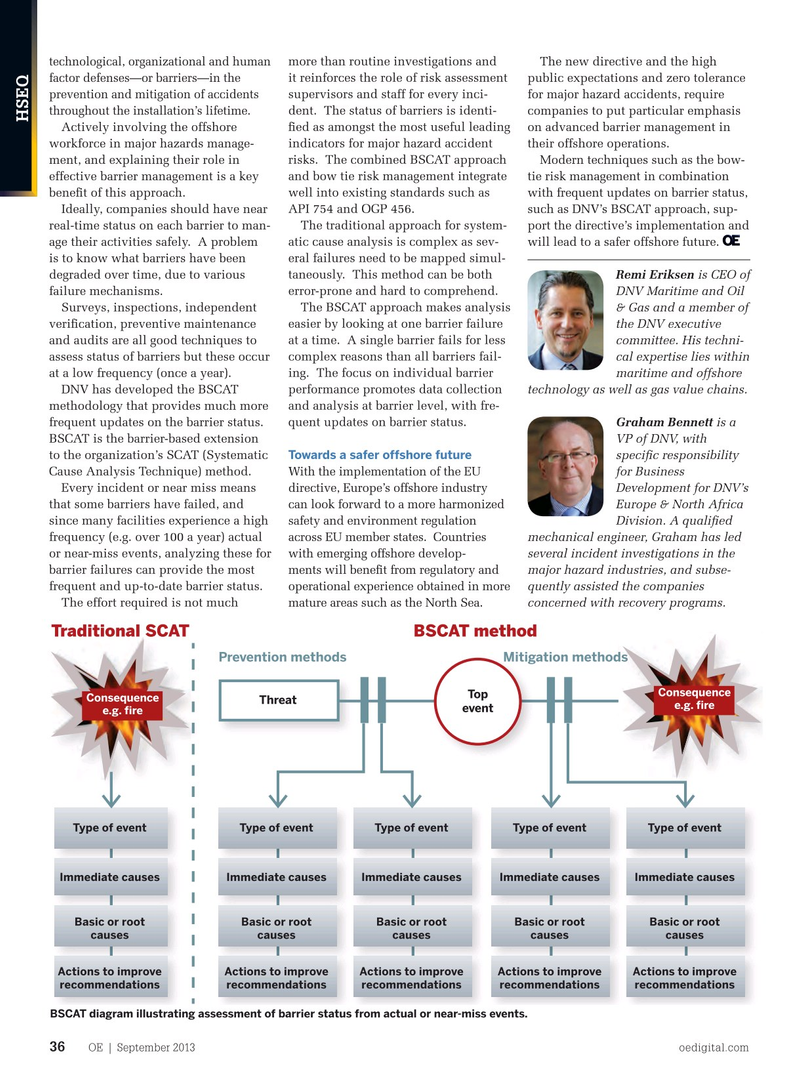
Page 34: of Offshore Engineer Magazine (Sep/Oct 2013)
Read this page in Pdf, Flash or Html5 edition of Sep/Oct 2013 Offshore Engineer Magazine
more than routine investigations and The new directive and the high technological, organizational and human it reinforces the role of risk assessment public expectations and zero tolerance factor defenses—or barriers—in the supervisors and staff for every inci- for major hazard accidents, require prevention and mitigation of accidents dent. The status of barriers is identi- companies to put particular emphasis throughout the installation’s lifetime.
HSEQ
Actively involving the offshore fed as amongst the most useful leading on advanced barrier management in workforce in major hazards manage- indicators for major hazard accident their offshore operations. ment, and explaining their role in risks. The combined BSCAT approach Modern techniques such as the bow- effective barrier management is a key and bow tie risk management integrate tie risk management in combination beneft of this approach. well into existing standards such as with frequent updates on barrier status,
Ideally, companies should have near API 754 and OGP 456. such as DNV’s BSCAT approach, sup- real-time status on each barrier to man- The traditional approach for system- port the directive’s implementation and age their activities safely. A problem atic cause analysis is complex as sev- will lead to a safer offshore future. is to know what barriers have been eral failures need to be mapped simul- degraded over time, due to various taneously. This method can be both Remi Eriksen is CEO of failure mechanisms. error-prone and hard to comprehend. DNV Maritime and Oil
Surveys, inspections, independent The BSCAT approach makes analysis & Gas and a member of verifcation, preventive maintenance easier by looking at one barrier failure the DNV executive and audits are all good techniques to at a time. A single barrier fails for less committee. His techni- assess status of barriers but these occur complex reasons than all barriers fail- cal expertise lies within at a low frequency (once a year). ing. The focus on individual barrier maritime and offshore
DNV has developed the BSCAT performance promotes data collection technology as well as gas value chains. methodology that provides much more and analysis at barrier level, with fre- frequent updates on the barrier status. quent updates on barrier status. Graham Bennett is a
BSCAT is the barrier-based extension VP of DNV, with to the organization’s SCAT (Systematic specifc responsibility
Towards a safer offshore future
Cause Analysis Technique) method. for Business
With the implementation of the EU
Every incident or near miss means Development for DNV’s directive, Europe’s offshore industry that some barriers have failed, and Europe & North Africa can look forward to a more harmonized since many facilities experience a high Division. A qualifed safety and environment regulation frequency (e.g. over 100 a year) actual mechanical engineer, Graham has led across EU member states. Countries or near-miss events, analyzing these for several incident investigations in the with emerging offshore develop- barrier failures can provide the most major hazard industries, and subse- ments will beneft from regulatory and frequent and up-to-date barrier status. quently assisted the companies operational experience obtained in more
The effort required is not much concerned with recovery programs. mature areas such as the North Sea.
Traditional SCAT BSCAT method
Prevention methods Mitigation methods
Consequence
Top
Consequence
Threat e.g. fire event e.g. fire
Type of event Type of event Type of event Type of event Type of event
Immediate causes Immediate causes Immediate causes Immediate causes Immediate causes
Basic or root Basic or root Basic or root Basic or root Basic or root causes causes causes causes causes
Actions to improve Actions to improve Actions to improve Actions to improve Actions to improve recommendations recommendations recommendations recommendations recommendations
BSCAT diagram illustrating assessment of barrier status from actual or near-miss events.
OE | September 2013 oedigital.com 36 032_OE0913_HSEQ1_DNV.indd 36 8/18/13 8:19 PM

 33
33

 35
35